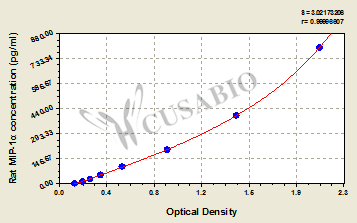Chemokine (C-C motif) ligand 3 (CCL3), also known as macrophage inflammatory protein 1α (MIP-1α), is a small cytokine belonging to the CC chemokine family. This protein recruits and activates immune cells, including macrophages, T cells, and natural killer cells, to sites of inflammation or infection. Multiple cell types produce CCL3, which acts as a chemoattractant that guides immune cell migration and activation during both innate and adaptive immune responses. CCL3 serves as an important mediator in inflammatory diseases and immune system regulation.
The Rat macrophage inflammatory protein 1α,MIP-1α ELISA Kit (CSB-E07422r) is designed for quantitative measurement of CCL3 in Rattus norvegicus samples. This sandwich ELISA works with serum, plasma, and tissue homogenates with a detection range of 12.5 pg/mL-800 pg/mL and sensitivity of 3.12 pg/mL. The assay requires 50-100ul sample volume, operates with detection at 450 nm wavelength, and can be completed within 1-5 hours.
Application Examples
Note: The following application examples are drawn from a selection of publications citing this product. For additional applications, please refer to the full list of references in the "Citations" section.
Researchers have used this ELISA kit to study inflammatory responses and cytokine profiling in various experimental contexts. Studies have applied the kit to quantify MIP-1α levels alongside other inflammatory mediators to examine immune system activation and inflammatory cascades. The kit has proven valuable for measuring this chemokine in both systemic circulation and localized tissue environments.
• Inflammatory research: Quantification of MIP-1α as part of comprehensive cytokine panels to evaluate inflammatory responses and immune system activation
• Arthritis and joint disease studies: Measurement of MIP-1α levels in both serum and synovial fluid to examine local and systemic inflammatory status in joint-related pathology
• Biomarker profiling: Integration with multi-analyte approaches to characterize inflammatory mediator patterns alongside other cytokines and growth factors
• Comparative inflammatory analysis: Measurement of MIP-1α levels in conjunction with related chemokines and cytokines to understand broader inflammatory networks






